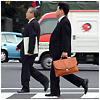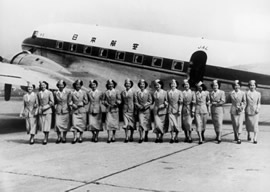Learn About Japan > Work and Workplaces in Japan > Employment > Female dominant occupations

|

Employment
- Group Employment Trips
- Spring Employment Season
- Hiring New Graduates
- Hiring New High School Graduates
- The Japanese Employment System
- Lifetime Employment
- The Seniority Wage System (nenkō joretsu)
- The Bonus System
- Enterprise Unions in Japan
- Enterprise Union Cooperation
- Unemployment Insurance
- Dual Tracks in Female Occupations: Ippan Shoku (Non-Career Track) and Sōgō Shoku (Career Track)
- Increase of Female Employees
- Female dominant occupations
- Post-Retirement Employment and Social Security
- Marriage Retirement and Retirement Ages for Men and Women
- Relations between Large and Small Companies
- Part-time Female Workers
- What Kinds of Work Do People Do in Japan?
- Freeter/ Furita: Part-Time Workers in Japan
|

The first airline stewardesses in Japan, 1951.
Photo from Mainichi Shimbun.
Female dominant occupations
Teaching is one of the most popular occupations among Japanese women. The number of female teachers is particularly high in preschool education, with over 90% of kindergarten teachers being female. The higher the level of schooling, the smaller the number of females among teachers. While over 60% of grade school teachers are females, the proportion of female faculty members at colleges and universities is only 20%. This includes many women who teach at women’s colleges and junior colleges. Women are active in occupations related to social welfare. They look after children at nursery schools. They are also caregivers and home helpers who work with the handicapped and the elderly. Women also play important roles in the medical arena. While they constitute only 10-20% of doctors and technicians, nurses, including public health nurses, are overwhelmingly women. Furthermore, over 60% of pharmacists are females. Many women also work in service industries. Being a flight attendant is one of the star occupations for young Japanese females. Click CHARTS to see the top five occupations that Japanese children chose as “what I want to be in the future.” Click PICTURES to see the photo of a nurses’ strike in the 1960s.
|
|
|
| Download Podcast in
English
| Japanese
|
|
Document |
Audio-Video |
Chart |
Picture |
Map
|
|

